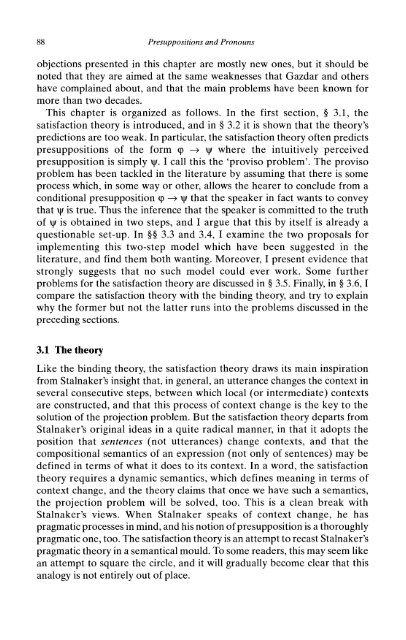Presuppositions and Pronouns - Nijmegen Centre for Semantics
Presuppositions and Pronouns - Nijmegen Centre for Semantics
Presuppositions and Pronouns - Nijmegen Centre for Semantics
Create successful ePaper yourself
Turn your PDF publications into a flip-book with our unique Google optimized e-Paper software.
88 <strong>Presuppositions</strong> <strong>and</strong> <strong>Pronouns</strong><br />
objections presented in this chapter are mostly new ones, but it should be<br />
noted that they are aimed at the same weaknesses that Gazdar <strong>and</strong> others<br />
have complained about, <strong>and</strong> that the main problems have been known <strong>for</strong><br />
more than two decades.<br />
This chapter is organized as follows. In the first section, § 3.1, the<br />
satisfaction theory is introduced, <strong>and</strong> in § 3.2 it is shown that the theory's<br />
predictions are too weak. In particular, the satisfaction theory often predicts<br />
presuppositions of the <strong>for</strong>m 'V \j/ where the intuitively perceived<br />
presupposition is simply'll. \|/. I call this the 'proviso problem'. The proviso<br />
problem has been tackled in the literature by assuming that there is some<br />
process which, in some way or other, allows the hearer to conclude from a<br />
conditional presupposition 'V \|/ that the speaker in fact wants to convey<br />
that'll \|/ is true. Thus the inference that the speaker is committed to the truth<br />
of 'V \|/ is obtained in two steps, <strong>and</strong> I argue that this by itself is already a<br />
questionable set-up. In §§ 3.3 <strong>and</strong> 3.4, I examine the two proposals <strong>for</strong><br />
implementing this two-step model which have been suggested in the<br />
literature, <strong>and</strong> find them both wanting. Moreover, I present evidence that<br />
strongly suggests that no such model could ever work. Some further<br />
problems <strong>for</strong> the satisfaction theory are discussed in § 3.5. Finally, in § 3.6,1<br />
I<br />
compare the satisfaction theory with the binding theory, <strong>and</strong> try to explain<br />
why the <strong>for</strong>mer but not the latter runs into the problems discussed in the<br />
preceding sections.<br />
3.1 The theory<br />
Like the binding theory, the satisfaction theory draws its main inspiration<br />
from Stalnaker's insight that, in general, an utterance changes the context in<br />
several consecutive steps, between which local (or intermediate) contexts<br />
are constructed, <strong>and</strong> that this process of context change is the key to the<br />
solution of the projection problem. But the satisfaction theory departs from<br />
Stalnaker's original ideas in a quite radical manner, in that it adopts the<br />
position that sentences (not utterances) change contexts, <strong>and</strong> that the<br />
compositional semantics of an expression (not only of sentences) may be<br />
defined in terms of what it does to its context. In a word, the satisfaction<br />
theory requires a dynamic semantics, which defines meaning in terms of<br />
context change, <strong>and</strong> the theory claims that once we have such a semantics,<br />
the projection problem will be solved, too. This is a clean break with<br />
Stalnaker's views. When Stalnaker speaks of context change, he has<br />
pragmatic processes in mind, <strong>and</strong> his notion of presupposition is a thoroughly<br />
pragmatic one, too. The satisfaction theory is an attempt to recast Stalnaker's<br />
pragmatic theory in a semantical mould. To some readers, this may seem like<br />
an attempt to square the circle, <strong>and</strong> it will gradually become clear that this<br />
analogy is not entirely out of place.














